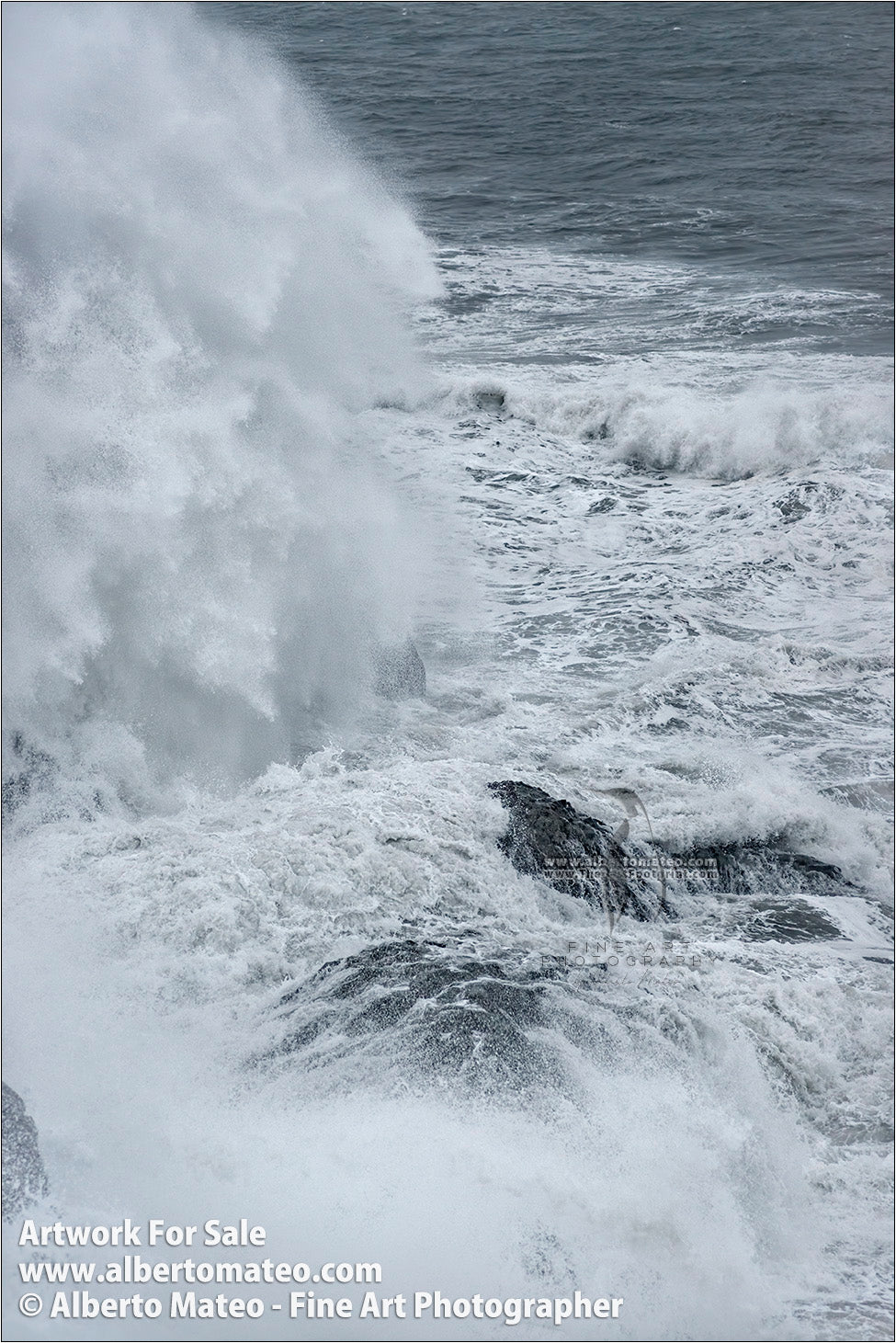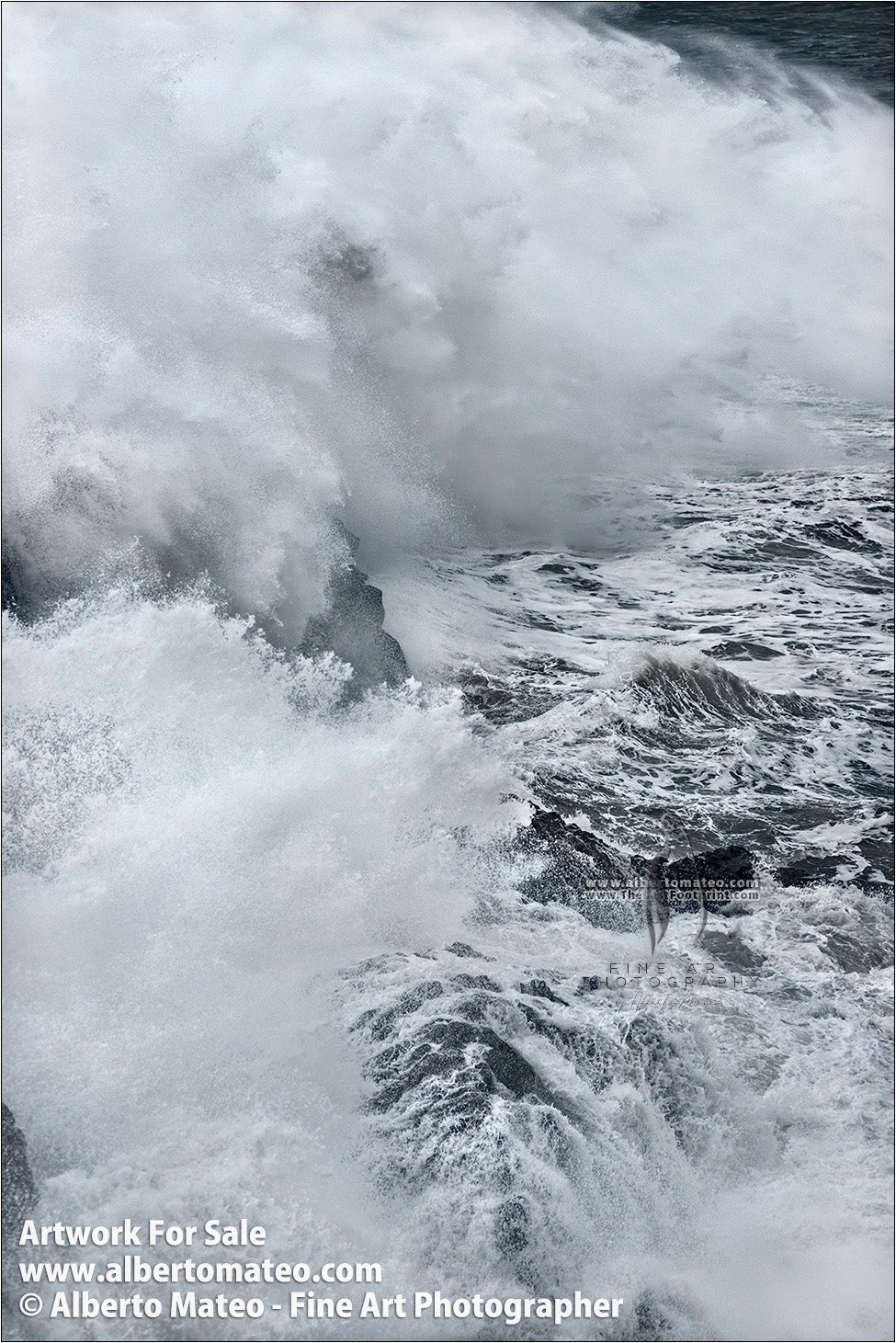Why don't you try a Series? [Breaking waves in gale, Dyorhaley, Iceland.]
"Breaking Waves Series, Dyorhaley, Iceland. Series of Five Fine Art Prints.
[1478 Words | Reading time: 7 min 20 seconds]





One of the most underrated instruments we photographers have in our toolkit is the SERIES or SEQUENCE: a set of images that altogether tell the story more efficiently than a single one. This has undoubtedly been the traditional territory of cinema whose ability to concatenate views converts it in the best way to transmit a whole complex action and its details. Photography is, in contrast, the only media able to concentrate all the expressive power of an action in an isolated picture. They both have its own field of use, but share some common ground, like the sequence in which a photographer uses a set of pictures to extend the creative power of its medium.
I would like first to make a distinction. There are two types of sequences:
We were used to sequences in the past in magazines and newspapers (called photo-essays), and nowadays can be seen on web galleries in digital media and photographer sites. However, I do not remember having seen many in photography forums like ‘National Geographic Your Shot’, where skilled photographers try their best doing good photography and presenting good work every-day. I suppose that one of the reasons is that it takes more work to prepare a complete series of related pictures than single images, or maybe that it is not the first possibility we photographers think about when we plan our photography work.
The series I present here is an example of the second case: the Action Sequence. The keys to creating an effective Action Sequence are:
My ‘Visual Zero’ image, in this case, is the first of the series, maybe the dullest of all, but the one that gives the eye something to compare with, the one that shows the bare lava rock without any wave breaking on it, the one that reveals the texture of the dark volcanic rock of Iceland coast. This photograph looks relatively ‘quiet’, although has strips of foam and water falling over it coming from the last wave that hit the rock some seconds before, and the sea around is everything but peaceful. But if we compare it with the next ones, we can describe it definitely as ‘quiet’.
"Select the key moments, set a 'Visual Zero', a picture to compare the rest of the images with, choose a perspective and fix it for the whole series."
Once you have set the ‘visual zero’, the viewer will be able to compare the curtains of white foam falling from the wave after breaking on the rocks with this ‘empty’ picture.
The other scenes I have selected for this series represent the moment when the water gets bounced back to the sea after hitting the volcanic rocks of the coast. I chose three views representing this moment as the main body of the sequence. The fifth and last photograph is a special moment when a wave that was very high (but not very powerful) spread upwards in a curtain of white foam. I selected it because it is a different moment than the three previous ones and gave a different view of the same process.
SHUTTER SPEED: My ‘limiting factor’ when shooting this scene was shutter speed. Silky threads of water look great for many landscape situations, but in my honest opinion, when the concept you want to transmit in your photographs is power, a fast shutter speed that freezes moving water is more effective. It was very late (after 21:00) when I shot these images, and there was not much light coming from the cloudy sky.
The sunset and dusk periods in Nordic Countries like Iceland are very long in summer, much longer than in lower latitudes. The light intensity decreases very slowly, and even the night is not completely dark.
I shot this image during dusk. The photometer (Matrix mode) gave me a reading of ISO 2000, an aperture of f2.8 and 1/500 of a second. Had I had more light I would have moved my settings to 1/1000 of a second and f4 (in this order) but would have had to use 8000 ISO, which is too noisy for my taste. When you make big prints you have to take care of the digital noise that looks awful when is seen at big reproduction sizes.
ISO SETTING: The advent of digital photography has brought us, photographers, some improvements in our cameras. Lens optic sharpness has not improved much during the last two decades, but autofocus and the ability of sensors to register an image in low light conditions are light-years away from what they were two decades ago.
Working with high ISO film (3200 ISO) was everything but satisfying some years ago. The results were so grainy and the colors so muddy and unsaturated that it was difficult not to get disappointed with the results, but nowadays high ISO quality images are available for most camera bodies, even the cheapest ones.
"The personal limit I have set to myself with my actual camera, the Nikon D800, at this moment is 1600 ISO, maybe 3200 ISO stretching the things to the limit."
The sensor quality and the taste of the photographer set the upper ISO limit to use under low light conditions. I have to say that my Nikon D800 sensor is a wonder, not only because it registers 36Mpx files (great for big prints!), but also because it can produce finely detailed big size reproductions when used even at high ISO settings. The personal limit I have set to myself with my actual camera, the Nikon D800, at this moment is 1600 ISO, maybe 3200 ISO stretching the things to the limit. I produce fine art prints (many of them at giant sizes) and do not like noisy prints (although sometimes I like grainy ones).
Two decades ago these images would have been impossible to take with enough quality.
PRINTING: The printing process for this series is not easy. A lot of care is needed to maintain detail in the lightest parts of the foam while adding a bit of contrast.
I prefer by far the black and white version of this series. Color adds little to this image. What is important in this photograph is the texture of the rocks and foam.
TRIPOD: No way around about this: to shoot a series like this you need one, and not a toy-size one. Other landscapes I took during my trip in beautiful Iceland could have been taken with a handheld camera, a tripod was a tool to improve my efficiency, but this series is absolutely impossible without a heavy and sturdy one because of two reasons:
- For the sequence to work the frame has to be 100% fixed. Otherwise, the sense of the sequences is lost or weakened. Mount your camera body on a tripod, set a focal distance and shoot.
- The wind was VERY strong and I was shooting from the top of a hill. I had problems even to maintain my balance and it was very hard even to change the SD card without losing it in the wind.
If you want to shoot landscapes buy a heavy tripod like the combination I use: Gitzo 1372M Magnesium Alloy Head on Manfrotto 055 Pro legs. A light tripod would not be very useful under strong wind conditions.
I even ballasted the tripod with a three kilograms sandbag I usually carry when I travel by car and expect adverse weather conditions to avoid movement. Sometimes the camera plus tripod weight is not heavy enough for the set to maintain a fixed position and reduce the vibrations the wind may cause.
"I ballasted the tripod with a three kilograms sandbag I usually carry when I travel by car and expect adverse weather conditions to avoid movement."
SECURITY: Tie your camera to anything you have at hand. I always carry a rope with two climbing karabiners in the backpack so that I can secure my camera body, tripod, backpack (or all of them) to anything. In this case, I was shooting next to a fence, so I secured my LowePro Backpack and the rest of my gear to it.
FILTER: I used a B+W 702M - 77mm Graduated Neutral Density 0.6 (2 stops) filter.
My highlights were in the foam on top of the frame, and the lower values of this scene were in the rocks located at the bottom of the picture, so using a two-stop ND Graduated Filter allowed me to reduce the general contrast of the image and retain detail on both extremes of the tonal scale: highlights and shadows.
For a landscape like this, you need a filter with a very soft transition. B+W transition is so soft and progressive that makes the use of the filter impossible to notice.
"Using a two-stop ND Graduated Filter allowed me to reduce the general contrast of the image and retain detail on both extremes of the tonal scale."
Most of the filters I use are B+W because the optical quality is stunning and the construction is great. It is ‘heavy’ when held on your hand because it is well made, and it lasts and lasts…
Next time you go out here to shoot a moving subject think about the possibility of dissecting the whole action in different parts, choose the most representative one and try to capture them. It usually takes more work, but it can show you new ways to see your every-day subjects and discover new creative instruments to tell the same story to your viewers. It can be a rewarding experience.
Related Series: EAT, DRINK, RELAX, London, United Kingdom.
Here you can see another series I took some years ago in London. I hope I can share some tips soon in this blog about how I took it and its conceptual meaning.
Eat, Drink, Relax, 1/4
Eat, Drink, Relax, 2/4
Eat, Drink, Relax, 3/4
Eat, Drink, Relax, 4/4
EXIF DATA:
Camera Model: Nikon D800
Lens: Nikon 80-200 AF used at 120mm
SETTINGS: Aperture: f2.8 | Shutter Speed: 1/500 seconds | ISO: 2000
LIST OF USED GEAR
Tripod: Gitzo 1372M Magnesium Alloy Head on Manfrotto 055 Pro legs
Backpack: LowePro with rain cover (absolutely needed in Iceland)
Filter: B+W 77mm GRAD ND (702M) 2 stops Graduated 0.6 Neutral Density Filter, 2 points, very soft transition.
Memory Card: Sandisk SD Extreme 64Gb
NEXT SCHEDULED POST: DC10-Airplane, Wreck, near Vik, Iceland.
These prints are available as an Open Edition Fine Art Print. Click the links to see them at my site.
Breaking Wave, Dyorhaley, Iceland. Fine Art Print Series 1/5
Breaking Wave, Dyorhaley, Iceland. Fine Art Print Series 2/5
Breaking Wave, Dyorhaley, Iceland. Fine Art Print Series 3/5
Breaking Wave, Dyorhaley, Iceland. Fine Art Print Series 4/5
Breaking Wave, Dyorhaley, Iceland. Fine Art Print Series 5/5

![Why don't you try a Series? [Breaking waves in gale, Dyorhaley, Iceland.]](http://albertomateo.com/cdn/shop/articles/Islandia_2018_Alberto_Mateo_T_180510_4752_1200x.jpg?v=1550746949)
0 comments